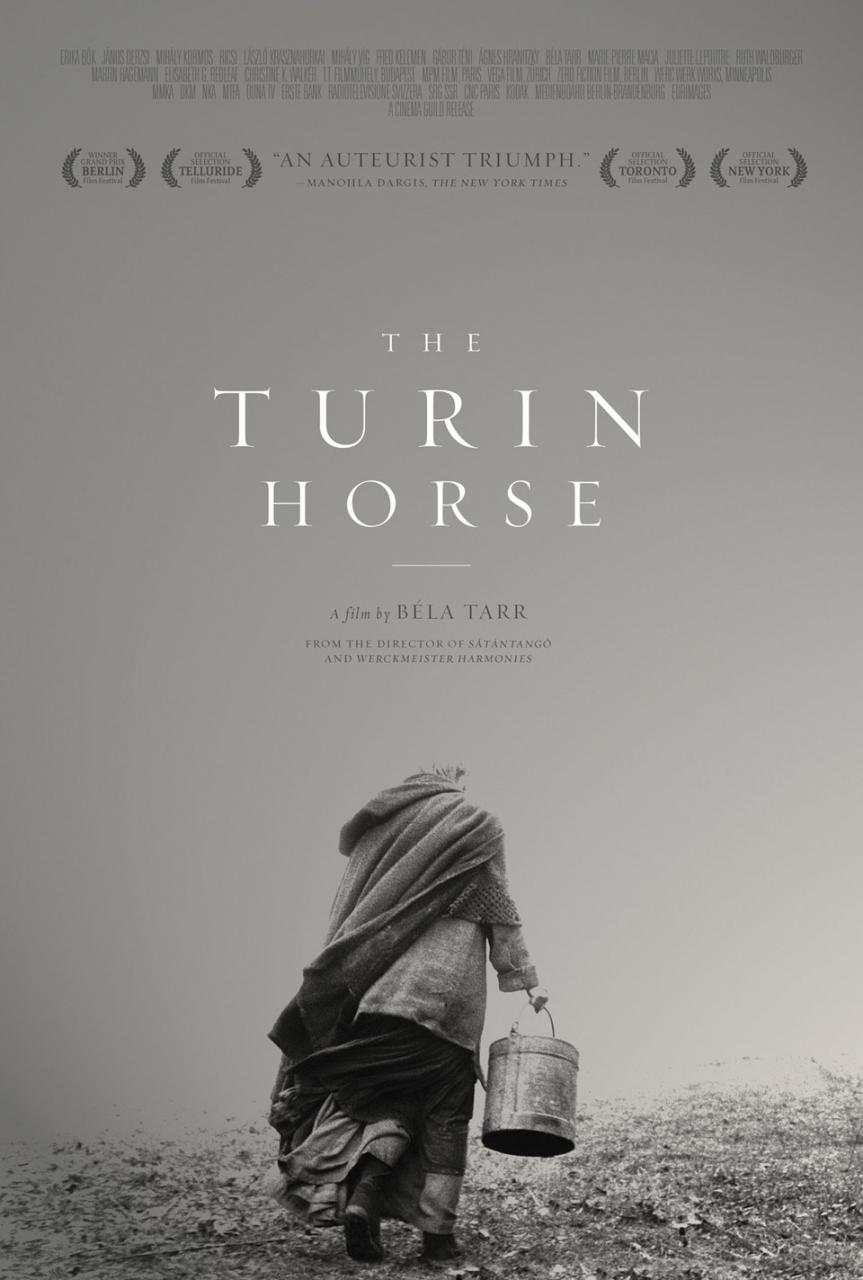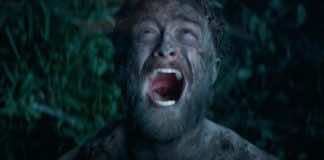 Legendary Hungarian director Béla Tarr’s latest film* is a focused work of evocative black and white artistry that patiently unfolds over a two-and-half-hour run time in a primitive land, probably just before the turn of the 20th century. Before the viewer is granted the varying shades of gray that cover The Turin Horse, the ingenious filmmaker gives us truly stark black and white: Opening titles of white, Times New Roman font, which briskly fade in and out against a pitch black background during nothing but silence. When the final title disappears, the screen remains black, and a baritone voice speaks in Hungarian (the film’s native language) of a famous story regarding Friedrich Nietzsche. During a walk in Turin, he comes across a horse cart coachman beating his steed, which has halted in its tracks. Despite the cabman’s angry, incessant lashings the horse refuses to budge. Distraught at the sight, Nietzsche fell into a decade-long depression that ended only with his own death. “Of the horse we know nothing,” the enigmatic narrator adds to this legendary tale. A beat later, the image of a gray horse (Ricsi) pulling a cart against a punishing wind fills the frame, as a plaintive string section backed by a noodling organ or possibly a hurdy-gurdy, churns out a driving, tragic melody indulging in repetitive minimalism.
Legendary Hungarian director Béla Tarr’s latest film* is a focused work of evocative black and white artistry that patiently unfolds over a two-and-half-hour run time in a primitive land, probably just before the turn of the 20th century. Before the viewer is granted the varying shades of gray that cover The Turin Horse, the ingenious filmmaker gives us truly stark black and white: Opening titles of white, Times New Roman font, which briskly fade in and out against a pitch black background during nothing but silence. When the final title disappears, the screen remains black, and a baritone voice speaks in Hungarian (the film’s native language) of a famous story regarding Friedrich Nietzsche. During a walk in Turin, he comes across a horse cart coachman beating his steed, which has halted in its tracks. Despite the cabman’s angry, incessant lashings the horse refuses to budge. Distraught at the sight, Nietzsche fell into a decade-long depression that ended only with his own death. “Of the horse we know nothing,” the enigmatic narrator adds to this legendary tale. A beat later, the image of a gray horse (Ricsi) pulling a cart against a punishing wind fills the frame, as a plaintive string section backed by a noodling organ or possibly a hurdy-gurdy, churns out a driving, tragic melody indulging in repetitive minimalism. The cart’s driver, Ohlsdorfer (János Derzsi), is an old but hard-looking man whose black and white beard flows and undulates against the whipping wind. The naked branches of the stripped trees look like cracks against a dusty, broken, gray sky with not a cloud in sight. The shot, though unbroken by splices, constantly changes— in signature Tarr style— with the camera floating from one angle to another, panning in and out of its subjects as dust and leaves blow up from the ground, as if the land is falling apart with every passing second.
The cart’s driver, Ohlsdorfer (János Derzsi), is an old but hard-looking man whose black and white beard flows and undulates against the whipping wind. The naked branches of the stripped trees look like cracks against a dusty, broken, gray sky with not a cloud in sight. The shot, though unbroken by splices, constantly changes— in signature Tarr style— with the camera floating from one angle to another, panning in and out of its subjects as dust and leaves blow up from the ground, as if the land is falling apart with every passing second.
Heightening the scene further is the anticipation that builds up during the plain, text-based black and white introduction, which gives way to this image that seethes a kinetic quality where nothing is still while maintaining a stark quality. It makes for a gloriously intricate shot in its awesome minimalism, and provides a brilliant set-up to the existential journey ahead in the deceptively straight-forward film. But do not mistake minimalism and straight-forward storytelling for simplicity. Though shots are held an average length of about 10 minutes, the camera proves a restless observer, as established by the dramatic opening scene, which lasts about eight minutes. Exquisitely photographed by Fred Kelemen, the camera remains in constant motion throughout the film, rotating, tracking and floating around its subjects, picking up one brilliant angle after another.
As dynamic as the camera behaves, its subjects are sullen creatures who seem to go through the motions of life simply because they are alive. The old man and his daughter (Erika Bók) barely converse besides noticing how the world is slowly coming to a stop around them. After they dine on a single boiled potato each  (and they do it several times over the course of the film, without edits, but from different views of the camera), they go their separate ways to sit in front of windows as if to watch television. They look out at the churning, dry waste, quiet and seemingly stupefied at what appears to be the never-ending disintegration of the world. After they go to bed one night, early in the film, the father notices something. “Can’t you hear them either?” he asks her, as they lie in bed off camera.
(and they do it several times over the course of the film, without edits, but from different views of the camera), they go their separate ways to sit in front of windows as if to watch television. They look out at the churning, dry waste, quiet and seemingly stupefied at what appears to be the never-ending disintegration of the world. After they go to bed one night, early in the film, the father notices something. “Can’t you hear them either?” he asks her, as they lie in bed off camera.
“What?”
“The woodworms, they’re not doing it. I’ve heard them for 58 years. But I don’t hear them now.”
“They really have stopped. What’s it all about, papa?”
“I don’t know.”
But the active viewer has lots of space to fill in the subtext. The Turin Horse is existentialism represented as cinema. The color palette of black and white and varying shades of gray compliments the wasteland this man lives off with only his horse and daughter.  They dwell in a decaying cottage on dry land with vegetation reduced to skeletal branches by the windstorm that never relents for the duration of the movie. In fact, the occasions when the musical score stops, which is the same piece that appeared with horse at the film’s opening, the ebb and flow of the wind, which only varies from harsh howls to harsher howls, provides and even more stark musical accompaniment. Everything around this man and his daughter appears weather-beaten. Any color that may have once existed has been blown away by this merciless wind.
They dwell in a decaying cottage on dry land with vegetation reduced to skeletal branches by the windstorm that never relents for the duration of the movie. In fact, the occasions when the musical score stops, which is the same piece that appeared with horse at the film’s opening, the ebb and flow of the wind, which only varies from harsh howls to harsher howls, provides and even more stark musical accompaniment. Everything around this man and his daughter appears weather-beaten. Any color that may have once existed has been blown away by this merciless wind.
The music by Mihály Vig complements the film elegantly. It’s churning cello offers a mournful, minor key melody, backed by the sustained hum of higher-pitched violins. Counter pointing and harmonizing with the cello is the hushed noodling of a ghostly organ that may as well have been played by Philip Glass. At times the organ part sounds so low it sometimes sounds like flutes. Get used to this minimalist but elaborate melody. Over the course of the film it fades in and out, only varying in volume and not much else. It might as well be covering the entire soundtrack, as it never seems to have a beginning and end, existing somewhere beyond the mortal lives of people. At one point, toward the film’s end, the now familiar melody appears so low that it seems almost hallucinatory.
Because the film is such a subjective experience, it would spoil the experience to describe more dramatic moments in the film. Suffice it to say that visitors do pass by the cottage to break up the monotony, including a drinking neighbor with a certain opinion on life that could resonate in today’s time. There are also lively gypsies that invite the daughter to life in America. But, in the end, the film does not cop out with any form of release or purpose for these characters. As the music drones, so do the days before what seems like a complete black out arrives, or could it be death itself? These people will never know because who knows if they were living to begin with?
*Could this be Tarr’s last film? See his answer to the final question in this “Huffington Post” interview here.
Trailer:
The Turin Horse is not rated, runs 146 min. and is in Hungarian with English subtitles. It plays in South Florida for one night only: Thursday, Mar. 22, at 8 p.m., at the Miami Beach Cinematheque, which loaned me a screener DVD for the purposes of this review, as part of the theater’s “Cinephile’s Choice” series [update: a second screening has been added, on April 25, at 8 p.m. New date: May 17, at 8 p.m.]. If you are outside South Florida, the film’s national screening dates can be found here.
Update 2, its now on blu-ray with lots of great extras. Purchase here to support this blog.
(Copyright 2012 by Hans Morgenstern. All Rights Reserved. This material may not be published, broadcast, rewritten or redistributed without permission.)











UPDATE: Encore Screening added: WED, April 25, 8pm,
so if you are not able to come tomorrow, (THU, March 22, 8pm), hopefully you can catch April 25. Advance Tics available HERE: http://www.MBCinema.com
Hello! I just wish to offer you a big thumbs up for your great info you have got right here on this post. I will be returning to your site for more soon.